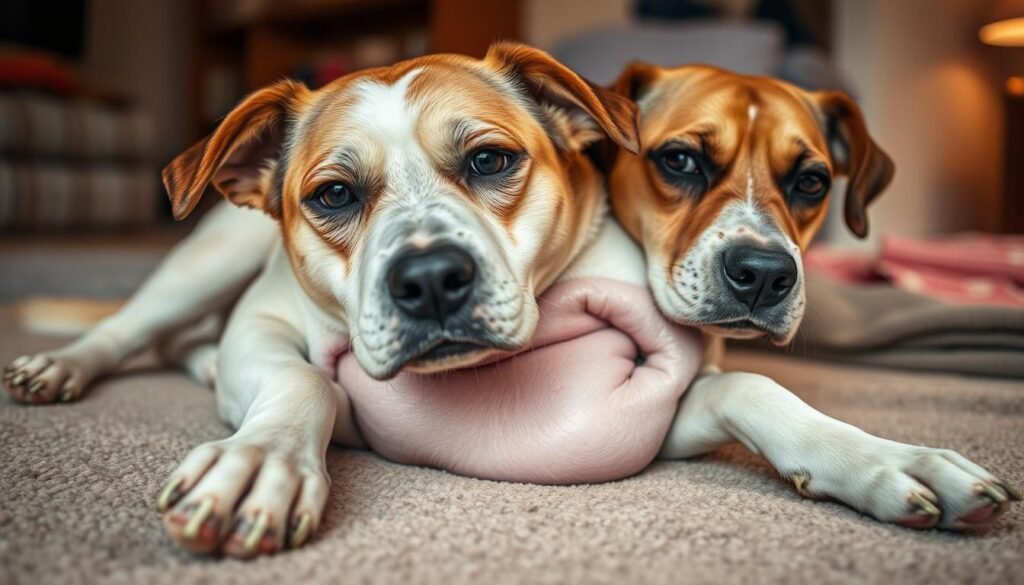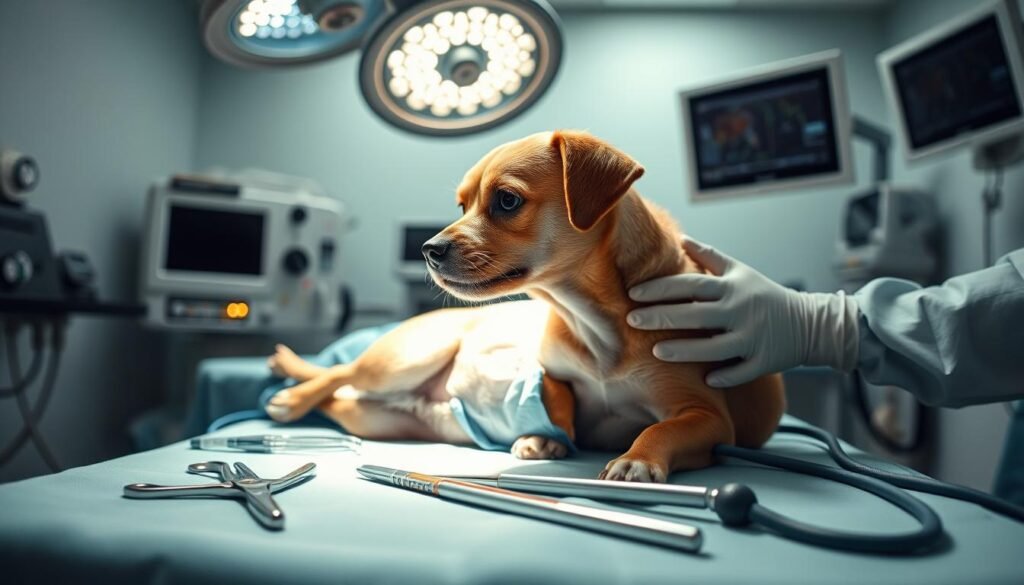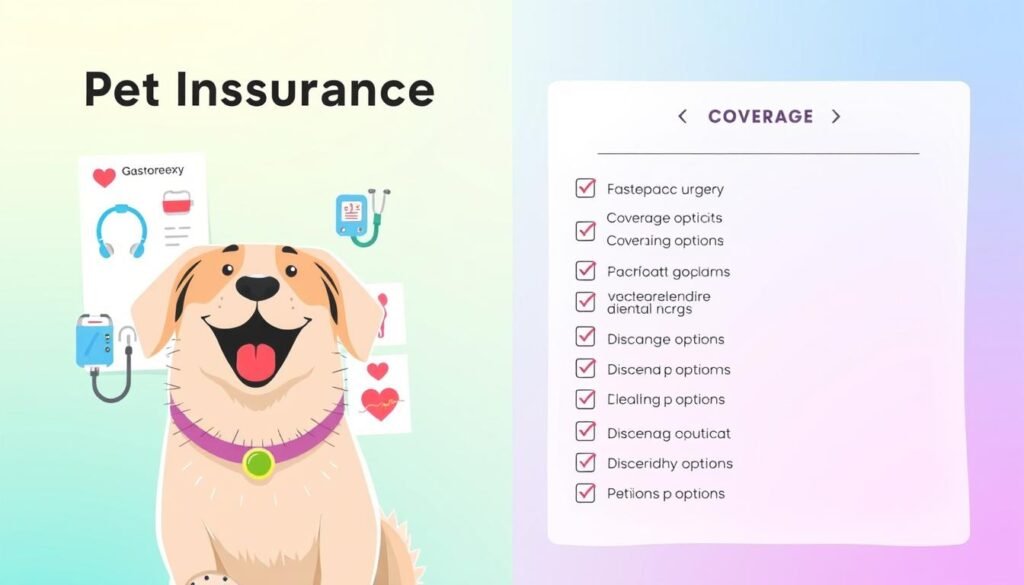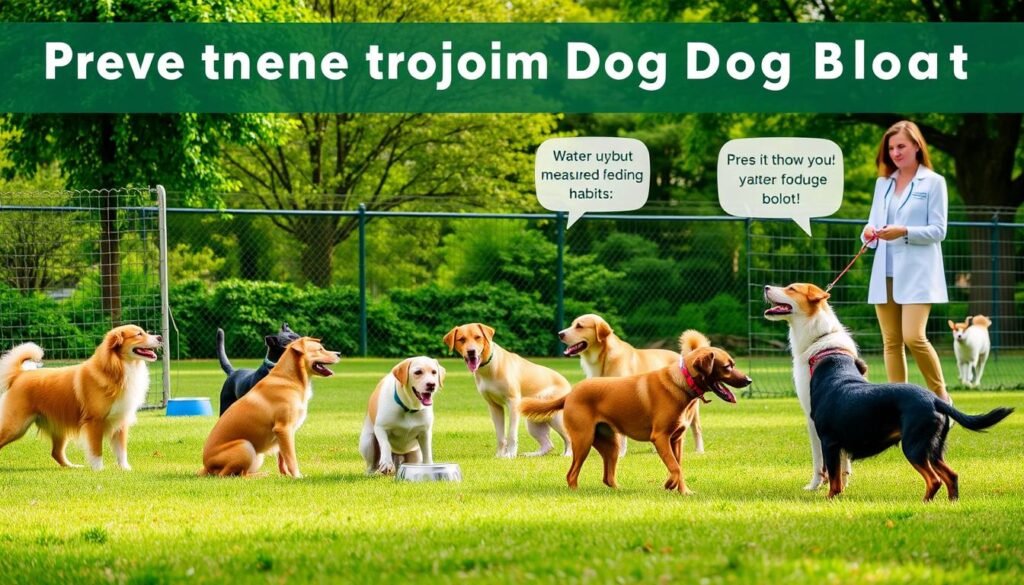Bloat, or gastric dilatation-volvulus (GDV), is a serious and potentially life-threatening condition in dogs1. Gastropexy, a preventative surgical procedure, can help reduce the risk of a dog developing bloat. But the question remains: Does pet insurance typically cover the cost of gastropexy? This article will explore the coverage of gastropexy by various pet insurance policies. It will also provide an overview of bloat, its treatment, and effective ways to prevent this dangerous condition.
Key Takeaways
- Bloat in dogs can lead to a life-threatening condition called gastric dilatation and volvulus (GDV)1
- Gastropexy is a preventative surgery that can help reduce the risk of bloat, but it is often considered an elective procedure and may not be covered by pet insurance12,
- Pet insurance typically covers standard bloat treatments, including surgery to correct the stomach position12,
- Factors like pre-existing conditions, breed-specific issues, and the type of pet insurance plan can affect coverage for gastropexy3
- Preventative measures like adjusting feeding schedules can help reduce the risk of bloat in dogs1
What Is Bloat in Dogs?
Bloat, or gastric dilatation-volvulus (GDV), is a serious condition in dogs. It happens when a dog’s stomach fills with gas, food, or fluid and twists4. This can block blood flow to the stomach and other vital organs, leading to quick decline if not treated fast4.
Causes and Symptoms of Bloat
Many things can cause bloat, like eating too fast, exercising after eating, and being a deep-chested breed4. Signs include a swollen belly, restlessness, drooling, vomiting, shallow breathing, and a fast heart rate4. If not treated, bloat can lead to shock, organ damage, and death4.
Dangers of Untreated Bloat
Bloat is the second leading cause of death in dogs, after cancer5. About 30% of dogs with bloat die, even with treatment6. The risk of bloat goes up by 20% for each year of a dog’s life6. Without quick vet help, the effects of untreated bloat can be very bad, making it a critical issue to address fast.
Bloat often affects large, deep-chested breeds or mixed-breeds with hollow chests, like Basset hounds, Doberman pinschers, Great Danes, Saint Bernards, and more45. Some breeds, like Great Danes, have a 42% chance of getting bloat in their lifetime5. Dogs with a family history of GDV are also at higher risk5.
“Bloat is a serious condition that requires immediate veterinary attention. Without prompt treatment, the consequences can be devastating.” – Dr. Jane Doe, Veterinarian
If you think your dog has bloat, get vet help right away. Quick action can greatly improve your dog’s chances and might save their life.
Standard Treatment for Bloat
When a dog gets bloat, or gastric dilatation-volvulus (GDV), the vet does a few things. They use tests to figure out what’s going on and might need to do surgery right away. The vet’s main goal is to make the dog stable and relieve the stomach to avoid more problems7.
Diagnostic Tests for Bloat
The vet will do X-rays or ultrasounds to confirm bloat. These tests show how big the stomach is and if it’s twisted7.
Surgical Intervention for Bloat
If the stomach is twisted, the vet might do an emergency surgery called a gastropexy. This surgery untwists the stomach and might attach it to the belly wall to stop future bloat78. The dog will also get fluids, antibiotics, and pain meds8.
A non-emergency gastropexy can cost a few hundred dollars. But, an emergency gastropexy can cost over $1,500. Stabilization and monitoring can add thousands more7.
Owners of high-risk dogs like Great Danes, Boxers, and German Shepherds might consider a preventative gastropexy. It can lower the risk of GDV death by up to 30 times78.

Does Pet Insurance Cover Gastropexy?
Protecting your dog is important, and knowing if pet insurance covers gastropexy is key. Gastropexy is a surgery that helps prevent bloat, a serious condition in dogs. But, the answer varies a lot, depending on the insurance policy9.
Many pet insurance plans don’t cover gastropexy because it’s seen as an elective procedure9. But, some might cover it if a vet recommends it for a dog’s breed or risk of bloat9. It’s important to check your policy to see what’s covered and what’s not.
Standard bloat treatment, like emergency surgery, is usually covered by pet insurance1. But, gastropexy itself might not be1. This can be a big worry, as gastropexy can cost between $1,500 and $7,5009. Understanding your policy well is key.
To protect your dog, look into pet insurance plans carefully. Consider adding a wellness plan or endorsement for gastropexy9. Knowing what your insurance covers helps you make the best choice for your dog.

Comparing Pet Insurance Policies
When looking for pet insurance to cover gastropexy for your dog, it’s key to compare policies carefully. Coverage for this surgery varies a lot among providers and plans. Important factors include your dog’s breed, what the policy calls “medically necessary,” and if it’s an accident-only or full accident and illness plan.
Factors Affecting Gastropexy Coverage
Some pet insurance companies only cover gastropexy if a vet says it’s needed, like for breeds at risk of bloat10. Others might not cover it at all, seeing it as an optional or cosmetic surgery10. Plans that cover accidents and illnesses usually offer more gastropexy coverage than those that only cover accidents10.
Also, pre-existing conditions, waiting periods, and exclusions can affect gastropexy coverage11. Knowing these details helps pet owners choose the best insurance for their dog’s needs.

When comparing pet insurance, read the fine print and ask about gastropexy and other surgeries for your dog. This ensures you get the right protection at a good price1011.
Preventative Measures for Bloat
As pet owners, it’s vital to prevent bloat, a serious condition, in our dogs. While insurance might not cover gastropexy, a surgery to prevent bloat, there are other ways to lower the risk. These steps can help keep your dogs safe from bloat12.
- Feed your dog smaller, more frequent meals throughout the day instead of a single large meal. This can help slow down their eating pace and prevent rapid intake of large amounts of food.
- Avoid strenuous exercise or playtime immediately before or after your dog’s meals, as this can increase the risk of bloat.
- Provide access to water in moderation, limiting their intake right before and after meals.
- Consider using a slow-feeder bowl or raising the food and water bowls to a comfortable height, which can further slow down their eating pace.
Dogs like Great Danes, Irish Wolfhounds, and German Shepherds are at higher risk of bloat13. Even if insurance doesn’t cover gastropexy, your vet might suggest it. Talking to your vet about prevention can lower your dog’s risk of bloat14.

Acting early and using these prevention tips can greatly lower the risk of bloat in your dog. By staying informed and working with your vet, you can keep your dog healthy and safe.
Top Pet Insurance Providers
Choosing the right pet insurance is key to protecting your pets. Lemonade, Embrace, Healthy Paws, and Nationwide are top choices. They offer various policy options and prices to fit different needs.
Most Affordable Pet Insurance
Lemonade and Embrace are great for those looking for cheap pet insurance. Lemonade starts at $59 a month for dogs and $32 for cats15. Embrace’s plans start at $12.95 for dogs and $8.95 for cats15. Pets Best even offers plans from just $6 a month15.
Best Holistic Pet Insurance Coverage
Healthy Paws and Nationwide are good for those wanting full coverage. Healthy Paws costs $33 a month for dogs and $17 for cats15. They cover many alternative therapies and preventative care. Nationwide offers a wide range of treatments, including acupuncture and chiropractic care.
| Provider | Average Monthly Premium (Dogs) | Average Monthly Premium (Cats) |
|---|---|---|
| Trupanion | $5915 | $3215 |
| Healthy Paws | $3315 | $1715 |
| Petplan | $2915 | $1815 |
| Embrace | $12.9515 | $8.9515 |
| Pets Best | Starting from $615 | Starting from $615 |
When picking pet insurance, look at monthly costs, deductibles, and what’s covered. Compare these to find the best and most affordable plan for your pet.
Filing a Claim for Bloat Treatment
If your dog needs emergency treatment for bloat, you’ll need to file a claim with your pet insurance. You’ll need to submit important documents like veterinary records and invoices. The insurance company might ask for more info about your dog, like their breed and age16.
Documentation Required
To make sure your claim goes smoothly, gather all needed documents. This includes:
- Veterinary records showing the diagnosis and treatments
- Itemized invoices for the emergency care costs
- Proof of payment, like receipts or bank statements
- Your dog’s breed, age, and medical history
Keeping good records from the start can make filing claims easier16. Some pet insurers pay the vet directly, while others need you to pay first and then claim back16.
It’s important to know how your policy handles claims. Make sure to submit all documents on time to avoid delays16.
“Proper documentation and a thorough understanding of your pet insurance policy are key to ensuring a smooth claims process for emergency treatments like bloat.”
Additional keywords: Additional keywords: does pet insurance cover cremation, pet cremation costs, pet burial insurance, pet final expenses coverage, pet insurance claims for euthanasia, pet death benefits, cremation fees for pets, reimbursement for pet cremation, pet cremation services covered, cost of pet cremation with insurance.
As pet owners, we want to ensure our furry companions receive the best care, even in their final moments. Pet insurance often covers medical treatments but also some end-of-life expenses like cremation and euthanasia17. This can help pet owners prepare for the inevitable and give their pets a dignified sendoff.
According to the Pet Loss Professionals Alliance, 99% of pet funerals involve cremation17. The cost can vary, with communal cremation being the least expensive at around $70 or less17. Private cremation can cost more, up to $250, depending on the pet’s size17. In-home euthanasia services like Lap of Love start at $400, with extra fees for size and travel17.
Some pet insurance providers offer benefits for end-of-life expenses. For example, Nationwide covers all fees related to a pet’s death, including euthanasia, burial, or cremation, as well as reimbursement for the pet’s purchase price up to a certain amount.17 But, coverage may have exclusions, such as not covering pets over a certain age17.
Other insurers, like Healthy Paws, cover euthanasia costs but not burial or cremation17. Companies such as Pets Best, Embrace, Trupanion, and FIGO also cover euthanasia but not cremation or burial services17. Fetch reimburses the full purchase price of pets that are euthanized due to injury or illness but does not cover cremation or euthanasia costs17.
When evaluating pet insurance policies, it’s important to review the details carefully. Some insurers offer add-on coverage or reimbursement for a portion of cremation fees or other final expenses, while others may have strict limitations or exclusions.171819
The cost of pet cremation and insurance coverage can vary greatly. It’s essential for pet owners to research and make informed decisions. This ensures their beloved companions receive the care and respect they deserve, even in their final moments171819.
Conclusion
Pet insurance policies vary a lot when it comes to gastropexy, a surgery to prevent bloat in dogs. Most plans cover standard bloat treatment but might not include gastropexy. This is because gastropexy is seen as an optional or preventive surgery20.
If you want to get gastropexy for your dog, you need to check your insurance policy carefully. Look at different insurance options and talk to your vet. This way, you can make sure your dog gets the care they need, even if gastropexy isn’t covered20.
Preventing bloat is also important. You can do this by feeding your dog smaller meals and not letting them exercise right after eating21.
In summary, while not all pet insurance covers gastropexy, knowing your policy well and talking to your vet can help. This way, you can make the best choice for your dog’s health. It’s key to understand the coverage, review your policy, and take steps to prevent bloat22.
FAQ
What is bloat in dogs?
What are the causes and symptoms of bloat in dogs?
What are the dangers of untreated bloat in dogs?
What is the standard treatment for bloat in dogs?
Does pet insurance cover the cost of gastropexy?
What factors affect whether pet insurance covers gastropexy?
What are some preventative measures for bloat in dogs?
What are some of the top-rated pet insurance providers?
What documentation is required when filing a pet insurance claim for bloat treatment?
Does pet insurance cover cremation, burial, or euthanasia costs?
Source Links
- Does Pet Insurance Cover Gastropexy or Bloat? Facts & FAQ | PangoVet – https://pangovet.com/insurance/does-pet-insurance-cover-gastropexy-bloat/
- Does Pet Insurance Cover Surgery? – https://www.progressive.com/answers/does-pet-insurance-cover-surgery/
- Nationwide Pet Insurance Plan Restrictions | Excluded Conditions – https://www.petinsurance.com/plan-restrictions/
- Bloat in Dogs | MetLife Pet Insurance – https://www.metlifepetinsurance.com/blog/pet-health/bloat-in-dogs/
- Bloat in Dogs: What it is & Treatment Options – https://www.trupanion.com/pet-blog/article/bloat-in-dogs
- Gastric Dilatation Volvulus (Bloat) in Dogs – https://figopetinsurance.com/blog/gastric-dilatation-volvulus-bloat-dogs
- Gastropexy in Dogs – https://www.petmd.com/dog/procedure/gastropexy-in-dogs
- Bloat in Dogs: Symptoms, Treatment & Prevention – https://www.carecredit.com/well-u/pet-care/bloat-in-dogs/
- Does Pet Insurance Cover Gastropexy or Bloat? Basic Coverage vs Added Costs | Hepper – https://www.hepper.com/does-pet-insurance-cover-gastropexy-or-bloat/
- What Does Pet Insurance Cover? – https://www.marketwatch.com/guides/pet-insurance/what-does-pet-insurance-cover/
- What Does Pet Insurance Cover? | ASPCA® Pet Health Insurance – https://www.aspcapetinsurance.com/research-and-compare/pet-insurance-basics/whats-covered/
- Laparoscopic or Endoscopic Gastropexy for the Prevention of GDV – Veterinary Specialty Center – https://www.vetspecialty.com/specialties/surgery/laparoscopic-or-endoscopic-gastropexy-for-the-prevention-of-gdv/
- Avoiding Bloat: A Preventative Approach with Gastropexy in Dogs – Lynbrook Vet – https://lynbrookvet.com.au/avoiding-bloat-a-preventative-approach-with-gastropexy-in-dogs/
- Should Your Dog Get a Gastropexy to Prevent Bloat? – https://www.kinship.com/dog-health/should-dog-get-gastropexy-prevent-bloat
- Everything You Need to Know About Buying Pet Insurance – https://nymag.com/strategist/article/best-pet-insurance.html
- Does Pet Insurance Cover Surgery? – NerdWallet – https://www.nerdwallet.com/article/insurance/does-pet-insurance-cover-surgery
- Does pet insurance cover cremation? – https://betterpet.com/pet-insurance-cover-cremation/
- Does Pet Insurance Cover Cremation? – DollarGeek – https://www.dollargeek.com/pet-insurance/does-pet-insurance-cover-cremation/
- Does Pet Insurance Cover Euthanasia or End-of-Life Care? – https://www.marketwatch.com/guides/pet-insurance/does-pet-insurance-cover-euthanasia/
- How To Treat Stomach Tacking In Dogs — CoFund My Pet – https://cofundmypet.com/how-to-treat-stomach-tacking-in-dogs
- Is Your Dog at Risk for Bloat? – https://www.petplace.com/article/dogs/pet-health/is-your-dog-at-risk-for-bloat
- Gastric Bloat And GVD In Dogs – https://www.metrovetchicago.com/services/dogs/blog/gastric-bloat-and-gvd-dogs
